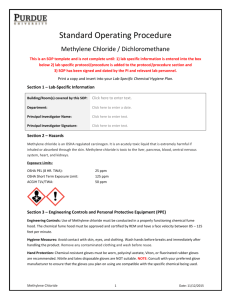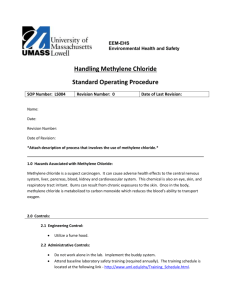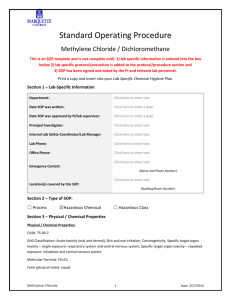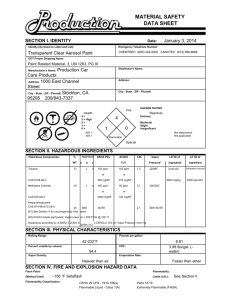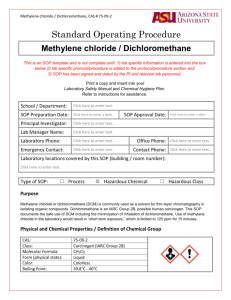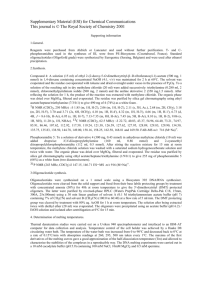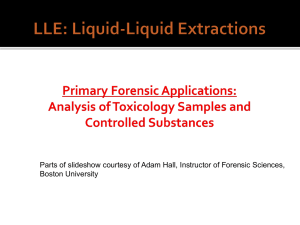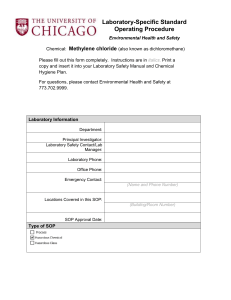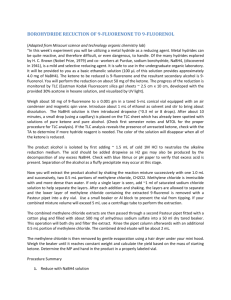Methylene Chloride - OSEH
advertisement
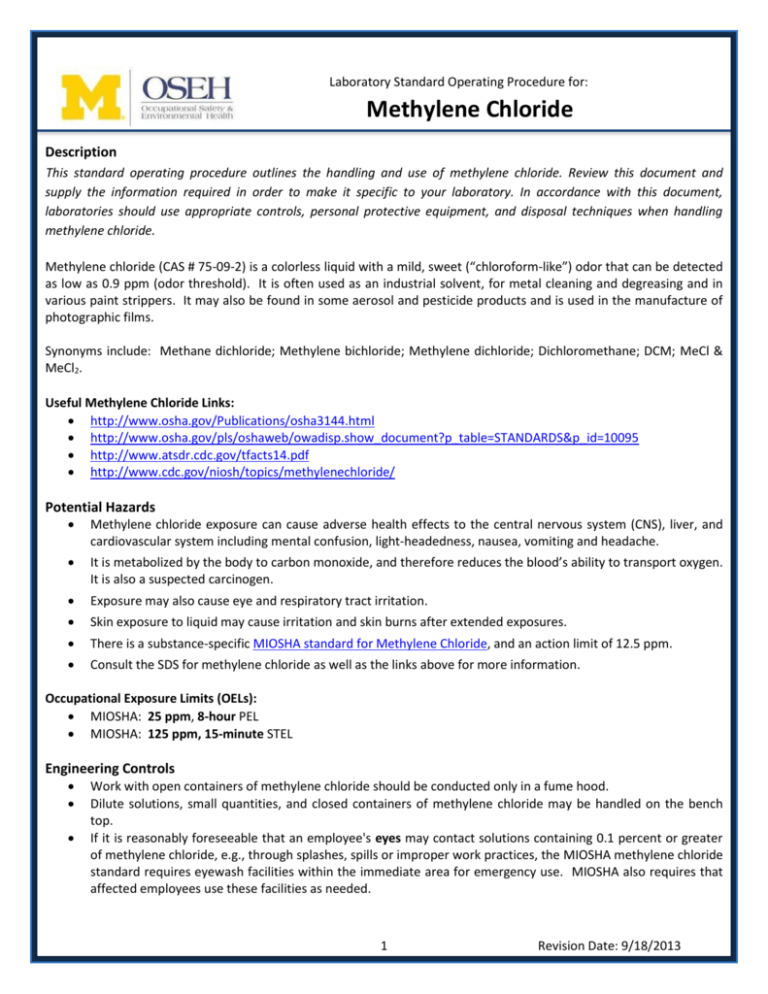
Laboratory Standard Operating Procedure for: Methylene Chloride Description This standard operating procedure outlines the handling and use of methylene chloride. Review this document and supply the information required in order to make it specific to your laboratory. In accordance with this document, laboratories should use appropriate controls, personal protective equipment, and disposal techniques when handling methylene chloride. Methylene chloride (CAS # 75-09-2) is a colorless liquid with a mild, sweet (“chloroform-like”) odor that can be detected as low as 0.9 ppm (odor threshold). It is often used as an industrial solvent, for metal cleaning and degreasing and in various paint strippers. It may also be found in some aerosol and pesticide products and is used in the manufacture of photographic films. Synonyms include: Methane dichloride; Methylene bichloride; Methylene dichloride; Dichloromethane; DCM; MeCl & MeCl2. Useful Methylene Chloride Links: http://www.osha.gov/Publications/osha3144.html http://www.osha.gov/pls/oshaweb/owadisp.show_document?p_table=STANDARDS&p_id=10095 http://www.atsdr.cdc.gov/tfacts14.pdf http://www.cdc.gov/niosh/topics/methylenechloride/ Potential Hazards Methylene chloride exposure can cause adverse health effects to the central nervous system (CNS), liver, and cardiovascular system including mental confusion, light-headedness, nausea, vomiting and headache. It is metabolized by the body to carbon monoxide, and therefore reduces the blood’s ability to transport oxygen. It is also a suspected carcinogen. Exposure may also cause eye and respiratory tract irritation. Skin exposure to liquid may cause irritation and skin burns after extended exposures. There is a substance-specific MIOSHA standard for Methylene Chloride, and an action limit of 12.5 ppm. Consult the SDS for methylene chloride as well as the links above for more information. Occupational Exposure Limits (OELs): MIOSHA: 25 ppm, 8-hour PEL MIOSHA: 125 ppm, 15-minute STEL Engineering Controls Work with open containers of methylene chloride should be conducted only in a fume hood. Dilute solutions, small quantities, and closed containers of methylene chloride may be handled on the bench top. If it is reasonably foreseeable that an employee's eyes may contact solutions containing 0.1 percent or greater of methylene chloride, e.g., through splashes, spills or improper work practices, the MIOSHA methylene chloride standard requires eyewash facilities within the immediate area for emergency use. MIOSHA also requires that affected employees use these facilities as needed. 1 Revision Date: 9/18/2013 If it is reasonably foreseeable that an employee’s skin may contact solutions containing 0.1 percent or greater methylene chloride, e.g., through splashes, spills or improper work practices, the MIOSHA methylene chloride standard requires conveniently located washing facilities capable of removing the methylene chloride. MIOSHA also requires that affected employees use these facilities as needed. Depending on the material’s pH or based on its ability to cause severe tissue damage, e.g., formaldehyde, methylene chloride, methyl ethyl ketone peroxide (MEKP), phenol, etc., the location of the emergency shower and/or emergency eyewash shall be within 25 feet from the hazardous operation. Work Practice Controls Designate an area for working with methylene chloride, and label it as such. Keep containers closed as much as possible. Handle open containers only in a chemical fume hood. Use in the smallest practical quantities for the experiment being performed. Typical laboratory use of methylene chloride should not put employees at risk of overexposure but labs using large amounts of methylene chloride should contact OSEH at (734) 647-1143 for exposure assessment. Once work with methylene chloride is complete, wipe down work area with soap and water solution. Keep away from ignition sources. Incompatible with strong oxidizers and metals. Wash hands thoroughly after use. Do not eat, drink or smoke in areas where methylene chloride or other chemicals are used. Personal Protective Equipment (PPE) Methylene chloride readily penetrates through standard nitrile, natural rubber and polyvinyl chloride laboratory gloves. Therefore, Viton, Neoprene or polyethylene vinyl alcohol and ethylene vinyl alcohol (PVA/EVA) gloves are recommended. Employee should use double gloves prior to working with methylene chloride. Disposable gloves provide minimum protection for general laboratory use and should be changed frequently or whenever contamination is suspected. Safety goggles should be worn when a splash hazard exists; safety glasses with side shields (both that meet the requirements of ANSI/ISEA Z87.1) are required at a minimum when methylene chloride is used in a closed system. A laboratory coat should be worn when working with chemicals. A chemically resistant apron should be used if transferring or using large quantities of methylene chloride in open containers. Also refer to OSEH’s Glove Compatibility Charts webpage. Transportation and Storage Transport methylene chloride in secondary containment, preferably a polyethylene or other non-reactive acid/solvent bottle carrier. Keep container in cool, well-ventilated area. Keep container tightly closed and sealed until ready for use. Store in secondary containment away from moisture, strong oxidizers, strong caustics, plastics, rubber, nitric acid, water + heat, and chemically active metals, such as aluminum and magnesium powder, sodium, potassium, and lithium. Avoid storing on the floor. Avoid ignition sources. Waste Disposal Most spent, unused and expired materials are considered hazardous wastes and must be collected and disposed of within 90-days by OSEH Hazardous Materials Management (HMM). Contact OSEH-HMM at (734) 763-4568 for waste 2 containers, labels, manifests, waste collection and for any questions regarding proper waste disposal. Also refer to OSEH’s Hazardous Waste webpage for more information. Exposures/Unintended Contact If the employee is in need of emergency medical attention, call 911 immediately. In general, flush affected eyes or skin with water for at least 15 minutes, then seek medical attention (see below). Eyes: In case of contact, immediately flush eyes with plenty of water for at least 15 minutes. Remove contact lenses, if present and easy to do. Continue rinsing. Get medical aid. Skin: In case of contact, flush skin with plenty of water. Remove contaminated clothing and shoes. Get medical aid if irritation develops and persists. Wash clothing before reuse. Ingestion: If swallowed, do not induce vomiting unless directed to do so by medical personnel. Never give anything by mouth to an unconscious person. Get medical aid. Inhalation: If inhaled, remove to fresh air. If not breathing, give artificial respiration. If breathing is difficult, give oxygen. Get medical aid. If there is any doubt about the severity of the injury, seek immediate medical attention. Contact OSEH for advice on symptoms of chemical exposure, or assistance in performing an exposure assessment. Report all work related accidents, injuries, illnesses or exposures to WorkConnections within 24 hours by completing and submitting the Illness and Injury Report Form. Follow the directions on the WorkConnections website Forms Instructions to obtain proper medical treatment and follow-up. Complete the OSEH Laboratory Incident and Near-Miss Report form. TREATMENT FACILITIES: U-M Occupational Health Services -- Campus Employees Mon-Fri 7:30 am - 4:30 pm After hours - go to UM Hospital Emergency Dept. – Urgent Care Clinic C380 Med Inn building 1500 East Medical Center Drive, Ann Arbor (734) 764-8021 University Health Services -- University students (non-life threatening conditions) Mon-Fri 8 am – 4:30 pm, Sat 9 am – 12 pm Contact for current hours as they may vary 207 Fletcher Street, Ann Arbor (734) 764-8320 UMHS Emergency Department -- after clinic hours or on weekends 1500 East Medical Center Drive, Ann Arbor, (734) 936-6666 For more information click here. Spill Procedures When a spill occurs, personal safety should always come first. Alert and clear everyone in the immediate area where the spill occurred. 3 A minor (small) chemical spill is one that the laboratory staff is capable of handling safely without the assistance of safety and emergency personnel, i.e., (less than 1 Gallon or 3.5 Liters). A major/large chemical spill requires active assistance from emergency personnel. Spill Response Steps: MINOR CHEMICAL SPILL Alert people in immediate area of spill. Open outside windows, if possible. Use proper personal protective equipment (PPE) as indicated above. Avoid breathing vapors from spill. Confine spill to as small an area as possible. Do not wash spill down the drain. Use appropriate spill kits/sorbents to absorb spill. Collect contaminated materials and residues and place in container. Contact OSEH-HMM (734) 763-4568 for proper disposal. Clean spill area with water. MAJOR CHEMICAL SPILL Report large chemical spills (greater than 1 Gallon or 3.5 Liters) in corridors or common areas, e.g., hallways, elevators, eating areas, rest rooms, offices, etc., to UM’s Police Department (UMPD) at (734) 763-1131 (or 911). Attend to injured or contaminated persons and remove them from exposure. Alert people in the laboratory to evacuate. If spilled material is flammable, turn off ignition and heat sources. Don’t light bunsen burners or turn on other switches. Call UMPD at 911 immediately for assistance. Close doors to affected area. Post warnings to keep people from entering the area. Have person available that has knowledge of incident and laboratory to assist emergency personnel. Additional Spill Links: www.oseh.umich.edu/pdf/chemspil.pdf http://www.oseh.umich.edu/emer-chemical.shtml. Report all emergencies, suspicious activity, injuries, spills, and fires to the University of Michigan Division of Public Safety and Security (DPSS) by calling 911 or texting 377911. Register with the University of Michigan Emergency Alert System via Wolverine Access. Training of Personnel All personnel are required to complete the General Laboratory Safety Training session (BLS025w or equivalent) via OSEH’s My LINC website. Furthermore, all personnel shall read and fully adhere to this SOP when handling methylene chloride. Certification I have read and understand the above SOP. I agree to contact my Supervisor or Lab manager if I plan to modify this procedure. Name Signature UM ID # 4 Date Prior Approval required – Is this procedure hazardous enough to warrant prior approval from the Principal Investigator? ☐ YES ☐ NO Principal Investigator Revision Date 5
